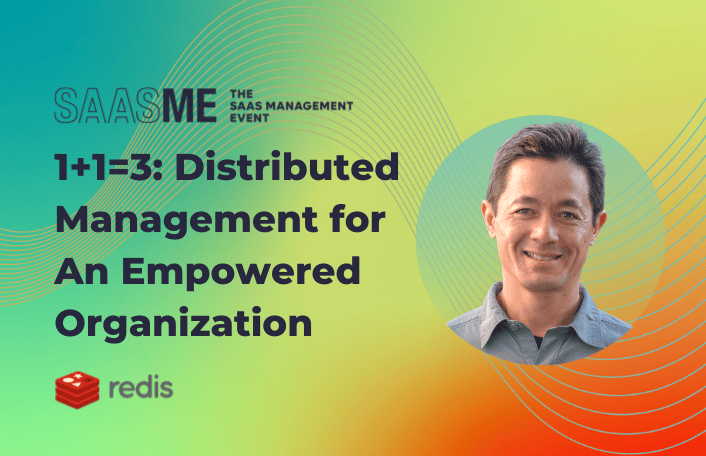11/15/2022
Table of Contents
SaaS has made it easier for organizations to acquire software and accelerate the time to value. As such, there’s no surprise in the explosion of SaaS we have seen over the preceding years. However, this has created a challenge for enterprises across industries. And that’s how to manage this software.
SaaS management shares many similar characteristics of its on-premise predecessors. Centralization of the core IT services is essential, yes. Yet, many of the middling services are left to the LOBs to manage and acquire. This decentralized purchasing has in turn led to app proliferation and severely reduced view into the software inventory that we had with on-premise software.
This means companies are facing licensing waste, increases in security risks, and a lack of governance in their applications.
That’s why Chris Asing, Head of IT and VP of Redis, joined us on SaaSMe 2022 to discuss the importance of creating a distributed management system for an empowered workforce. As head of IT at Redis, Asing enabled distributed ownership across the organization, defined what tools should be centrally managed, and empowered application owners with decentralized management. Ultimately, this resulted in a better employee experience for all at Redis.
Here’s what Asing had to say.
Answer Three Basic Questions
Asing shared with us the basic questions he aims to answer with distributed management of SaaS as part of Redis’ goals for continued growth and scalability.
These questions allow you to determine if an application or service is helping you make money, save money, or stay compliant. Answering the first two means determining if an app is faster, better, and cheaper. Should it fail to meet these criteria, it’s time to look at how you can solve that with data and open the discussion with your LOBs.
“What makes sense for the time and maturity state?” Said Asing. “From a competitive metrics perspective, are we even talking about pricing? Are we talking about terminations for convenience, volume stepped-down pricing? All those sorts of things are part of what we need to check our navel with and sort of ask ourselves, are we ready to take these on and be truly committed to them?”
The last of these questions is a matter of security. Does this particular SaaS help you stand up to any number of audits? One of the biggest problems of shadow IT is that it is impossible to know your compliance risks if you don’t know they’re there.
“And then from a compliance and due diligence and reporting perspective,” said Asing, “are we focused on those really important pieces? The data privacy, the PII, the intellectual property. And the identity government’s components are just SAML 2.0, and some of the provision capabilities that are offered by these SaaS products.”
Partnership and Collaboration
Communication and partnership across an organization are always vital to achieving an effective SaaS management strategy. This is also what Asing found in his efforts to establish decentralized SaaS management at Redis.
“We’ve been talking about it as a partnership.” Said Asing. “And it is so true. It really is about this strong interlock with the business to again meet them where they are, and in some cases, having them be patient with us as well.”
In this, we see how SaaS management takes a collaborative effort between those responsible for centralized SaaS management, such as IT, and LOB app owners. It isn’t about taking complete control, but rather setting flexible guidelines to work within.
Key Takeaways on Distributed Management
Be a Cloud-First Organization
In the process of distributed SaaS management, being a cloud-first organization is incredibly helpful. It allows your organization to tap into the important points you need to be considering in your SaaS. That’s the real-time consumption and activity of each respective SaaS. From there you can consider how your SaaS is working for you.
If it isn’t working, you’re able to take an iterative approach, picking a handful of challenges to work on until you succeed with your desired outcome. You can then adopt that approach throughout your organization, and apply it to other important aspects of your SaaS stack.
Overall, a cloud-first approach allows for flexibility and an iterative design approach in distributed management.
Data is Key
To get started, your organization needs to answer some basic questions about SaaS management. You have to start with data. Measure what you can, the usage, the spending, everything. In the process, you’ll be answering questions such as “Where are the contracts? How do we find them? Who owns the application?”
This data reflects the process and the progress of the change in SaaS management for your organization and LOBs.
According to Asing, you should use this data to start with the low-hanging fruit and pick a handful of things in your organization you really want to change. SaaS Management isn’t a sprint. Start small and work up.
“There’s no need to get superfluous,” said Asing, “And no need to get super visionary. Just get a few things and nail it, and iterate off of those foundational elements. It’s really the only way. There’s really no shortcutting the data.”
Seek Feedback & Mature Your Service/Business
One of the most important elements of distributed management is listening to feedback. Communicate with your LOB leaders. Many organizations are ready to take a deeper look into their annual budgeting plans against the actual activity. There are also organizations just not at that point. Either way, you need to get the conversation on SaaS management going.
Find out what is working for your business and what isn’t.
Then you can take that feedback, and incorporate it into your management process. With your feedback and data, you can use that information to mature your service/business. This means continuously tracking this data and maturing your business, making optimization a part of your enterprise architecture rather than a one-time project. Along the way, you provide employees and LOB leaders with the tools they need to do their job while maintaining cost efficiency across your entire organization.
“You implement the SaaS platform, you organize, and then you optimize.” Said Asing. “So, if you’re starting at ground zero, there’s a lot of low-hanging fruit. You just organize yourself and then figure out what you’re going to optimize from there.”
Final Thoughts
The bottom line is that distributed management of your SaaS empowers you to create a flexible and iterable system. It empowers your organization and your app owners with the tools they need to succeed without sacrificing compliance or efficiency.
According to Asing, this approach to SaaS management is more likely to produce better, faster, and cheaper results than centralized IT management. It just takes data, flexibility, collaboration, and a willingness to adopt an iterative approach to SaaS Management.
ABOUT THE AUTHOR

Zylo
Zylo is the leading enterprise SaaS management platform that transforms how companies manage and optimize the vast and accelerating number of cloud-based applications organizations rely on today. The platform provides one system of record for all cloud-based software purchased across a company, enabling customers to discover, manage, measure and optimize cloud investments with real-time insights into spend, utilization and feedback data.

